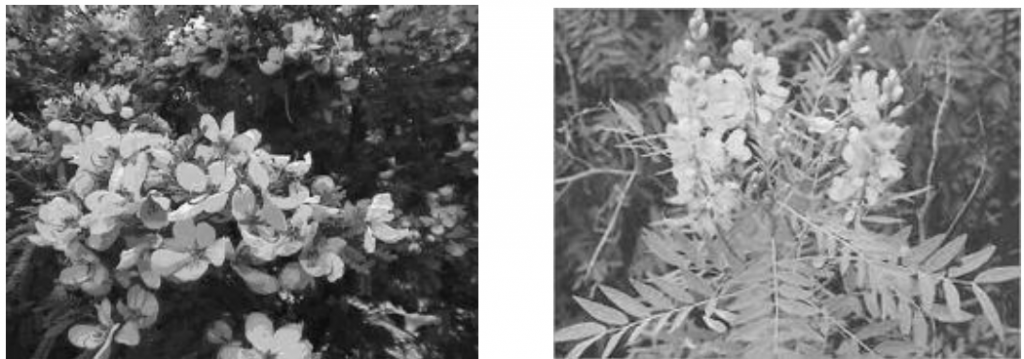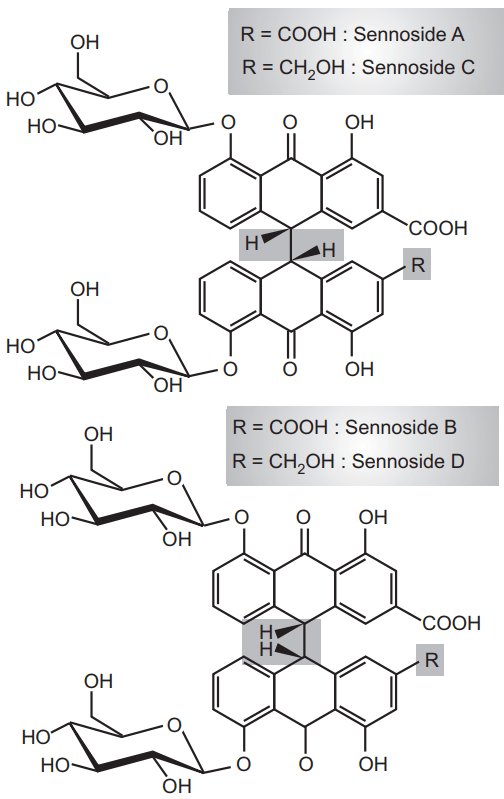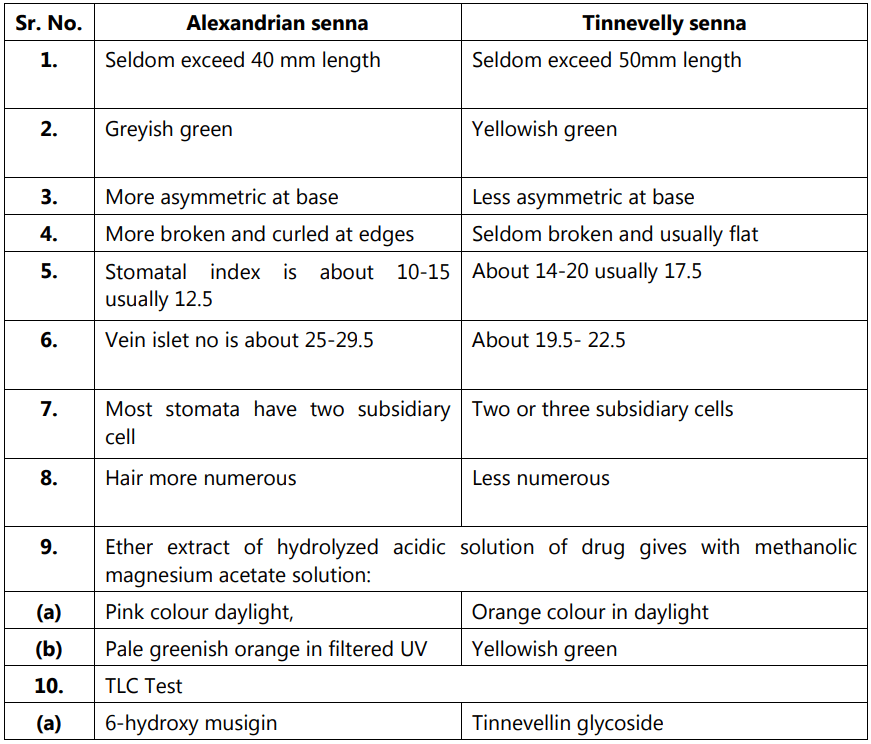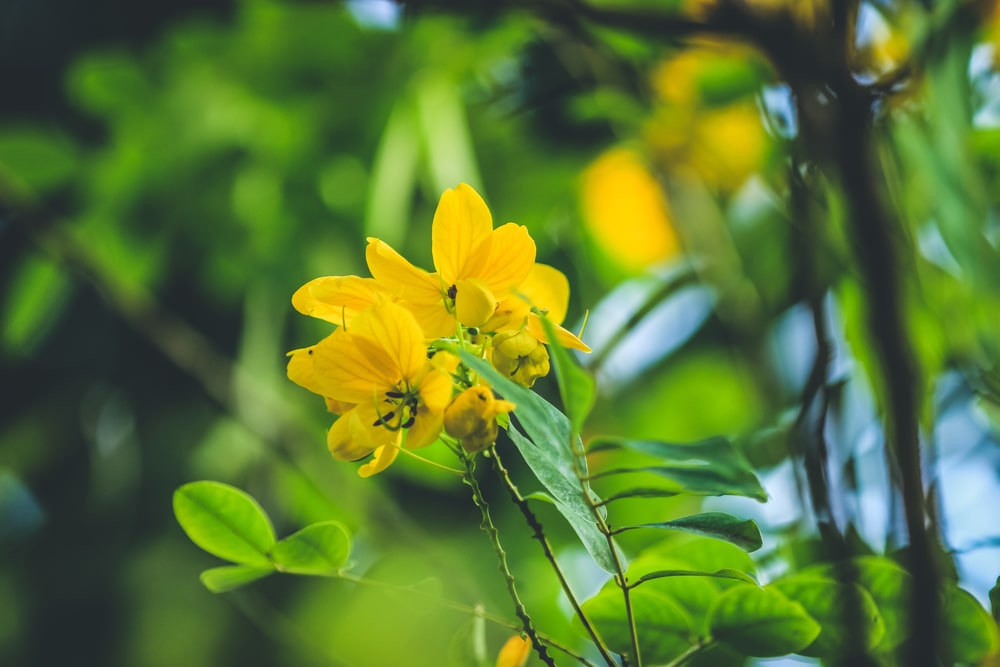Senna is an example of anthraquinone glycoside. Anthraquinone glycosides are mainly found in dicot families like Euphorbiaceae, Ericaceae, Polygonaceae, Rhamnaceae, Rubiaceae, Leguminosae, Verbenaceae, etc. The monocot family Liliaceae also shows the presence of this glycoside. The aglycone part of these glycosides is formed by head-to-tail condensation of acetate units. This glycoside comprises the aglycone part like anthraquinone, anthrone, anthranol, dianthranol, oxanthrone, and dianthrone. The anthraquinones are more biologically active in reduced forms. In fresh drugs, these are present in reduced forms but get oxidized and hydrolyzed upon storage.
Synonyms: Senna leaf, Tinnevelly senna, Alexandrian senna, Cassia senna, Indian senna.
Biological source: It consists of dried leaflets of Cassia Angustifolia or Cassia senna Vahl (Tinnevelley senna) and Cassia acutifolia Delile (Alexandrian Senna).
Family: Leguminosae

Geographical source: C. Angustifolia (Indian senna) is cultivated in Tinnevelley, Madurai, Tamilnadu (Ramanathapuram District), Andhra Pradesh, Gujarat, and Rajasthan. Cassia acutifolia (Alexandrian senna) is indigenous to tropical Africa and is cultivated in Sudan, the Middle, and upper Nile territory.
Cultivation and Collection of Senna
Table of Contents
Senna is used as cathartic from ancient times and it has also been included in the Unani system of medicine. Near about 26 species are well known which contain anthracene derivatives in free form or the glycosidic state. Among them Cassia angustifolia and Cassia acutifolia are in official monograph of pharmacopoeias. They are available abundantly. For the cultivation of senna near about 25 thousand hectares of land is used in India which produces 22 thousand tons of leaves and 75 thousand tones of fruits per year. It is a small shrub having 1.5 meters in height contains compound paripinnate leaves. Generally the red loamy or coarse gravelly soil is required for its better cultivation but it can also grow in alluvial loamy soil. The land is ploughed twice before the sowing of seeds. The sowing is done by the broadcasting method. The first sowing should be done in February or march whereas the second sowing can be done in October or November. Seeds have hard seed coats. A certain amount of abrading of its surface is necessary to induce quick germination. It is achieved by pouring the seeds lightly with coarse sand in a mortar. About 20 to 25 kg/hectare seeds are required. The plants favor light irrigation for better development. Waterlogging or heavy irrigation should be avoided. It is a sun-loving crop, grown in early summer (February to March) or winter (October to November). Leguminous fertilizers are applied from time to time. The plants are allowed to grow for about 5 months till the flower stalk gets developed.
The harvesting can be done after 2-3 months in three stages. In the first stage, the leaves are plucked out when leaflets are thick, fully grown, and green in color. The second plucking should be done after one month and the third plucking should be done after 4-6 weeks. After the third plucking, the plants are uprooted. The sennosidal content is maximum when leaves are fully grown. It is observed that the senna yield is good if it is cultivated after rice crop on the same field. After collection, the leaflets are dried under shade by spreading them in thin layers. The leaves are dried after 10-12 days and turn yellowish-green in color. The leaves are separated and packed into bales under a vacuum and stored in a dark and cool place. The leaves can be used for up to 5 years because it does not lose potency.
Macroscopic Character of Senna
- Colour: Yellowish green.
- Odour: Slight.
- Taste: Mucilaginous and bitter.
- Size: 20- 60 mm in length and 7 to 8 mm in width.
- Shape: Leaves are lanceolate, the entire apex is acute with the spine at the top
Other characteristics are small, perennial, under shrub below 1m in height with ascending branches; flowers are bright yellow. The full-grown leaflet emits a characteristic of smell when crushed. Flowers are not season bound and are brome between 35 to 70 days of age. The other species is very similar to C. Angustifolia in morphology and growth except in the dimension of its leaflets and pods which are shorter and narrow.
Chemical Constituents of Senna
The composition of the follicles and pods of the two official species is very similar and the differences are quantitative rather than qualitative. Both species contain flavonoids, a polyol (pinitol) acidic polysaccharide anthra quinones. Alexandrian senna is characterized by 6-hydroxy-musizin glucoside and Tinnevelley senna is characterized by Tinnevellin glucoside. The major components of the dried drug are sennosides which are glycosides of dianthrone type aglycone in other words Sennidins. Sennoside A and B are major components and they are 8, 8′ diglucoside of asymmetrical homodianthropic aglycone, dirhein anthone. The dianthrone derivatives do not exist in fresh senna which mainly contains the 8 glucosides of rhein-anthrone and aloe-emodin anthrone. Senna leaf also contains other anthraquinone glycosides in small amounts. They are sennosides C and D, rhein- 8- glucoside, rhein 8-2 Diglucoside and aloe-emodin. It also contains phytosterol, mucilage, resin, myricyl alcohol, chrysophanic acid, salicylic acid.

Chemical Test of Senna
Borntrager’s test: The drug is boiled with dilute sulphuric acid and filtered. To the filtrate add benzene or ether or chloroform and shake well. Separate the organic layer and slowly add ammonia into it. Pink to red color showed in an ammoniacal layer which confirms the presence of anthraquinone glycosides.
Allied drug: Cassia podocarpa, Cassia auriculata (Palthe senna) and Cassia obovata (Dog Senna)

Uses of Senna
Senna and its preparation uses as purgative in habitual constipation. The anthraquinone part of the senna gets absorbed in the intestinal tract after which the aglycone part is separated and excreted in the colon. These excreted anthraquinones irritate and stimulate the colon which increases the movements of the colon due to local action. The increased peristalsis causes a reduction in water absorption and results in soft and bulky faeces. The gripping effect of senna is due to its resin or emodin content. The drug is dispensed along with carminative to counteract the gripping effect. The drug given by parenteral way is secreted in the colon which causes the pharmacological action.
Make sure you also check our other amazing Article on : Colophony
